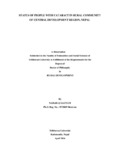Please use this identifier to cite or link to this item:
http://archive.nnl.gov.np:8080/handle/123456789/182| Title: | Status of People with Cataract in Rural Community of Central Development Region, Nepal |
| Authors: | GAUTAM, NABARAJ |
| Keywords: | cataract, ecological zones, Nepal, socio-economic status, visual impairment |
| Issue Date: | 24-Mar-2019 |
| Abstract: | This dissertation entitled Status of People with Cataract in Rural Community of Central Development Region, Nepal has set three objectives: i) to identify the sociodemographic characteristics of the households of people with cataract, ii) to analyze the status of people with cataract and the effects of cataract on their socio-economic development, and iii) to identify the knowledge, practices and barriers of people with cataract. Three VDCs, namely Dhunche, Ramche and Basdilwa from the Central Development Region were purposively selected based on road access from Rasuwa (mountain), Sindhupalchowk (hill) and Parsa (terai) respectively. First of all, the total number of households of three select VDCs was obtained from VDC offices and then a sample size was determined using the standard formula. The sample size thus obtained was 251, which is 12.5% of the total number of households i.e., 2000. Therefore, 12.5 % of households from each VDC and ward were included in the study as part of proportional sampling. If there was no at least one cataract member in the selected households, another household closer to that household was selected for the household interview to meet the necessary requirement of being people with cataract. The number of people with cataract was ascertained by visual acuity testing; only those who had visual impairment with cataract were taken for the household survey. Of the total people with cataract (Dhunche, 71; Ramche, 103; and Basdilwa, 209), only 33% people with cataract of each VDC were interviewed to understand the status of people with cataract and the effects of cataract on their socio-economic development. Therefore, 24 people from Dhunche, 34 from Ramche, and 69 from Basdilwa were taken for the interview. The household survey and the populationbased survey were conducted using the semi-structured questionnaire. |
| URI: | http://103.69.125.248:8080/xmlui/handle/123456789/182 |
| Appears in Collections: | 300 Social sciences |
Files in This Item:
| File | Description | Size | Format | |
|---|---|---|---|---|
| Nabaraj Gautam.pdf | 5.07 MB | Adobe PDF |  View/Open |
Items in DSpace are protected by copyright, with all rights reserved, unless otherwise indicated.